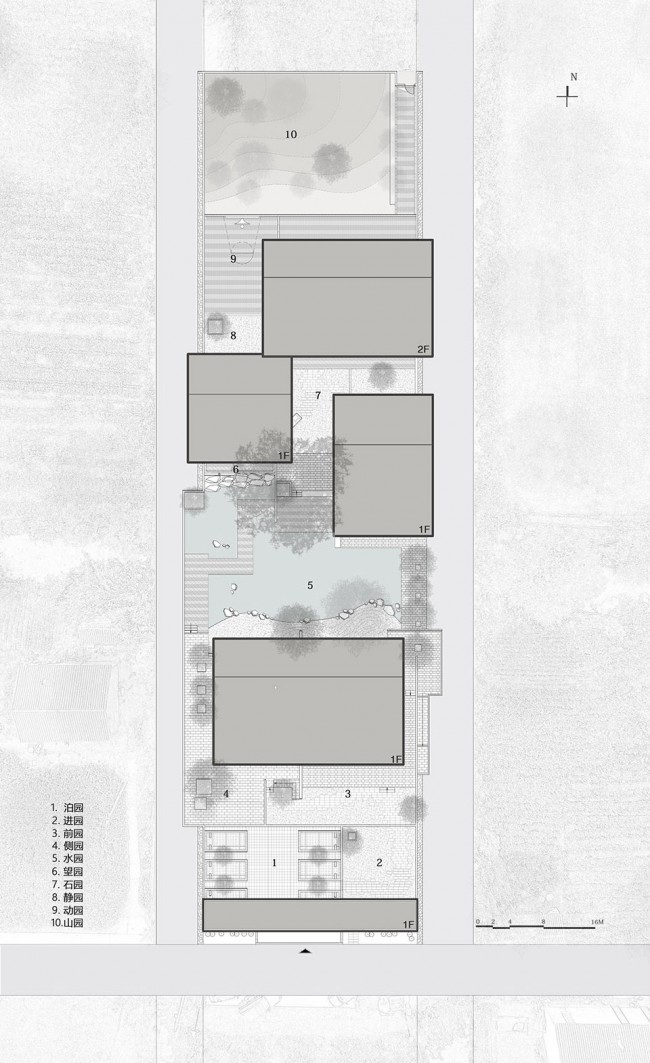来自 素建筑设计事务所 对gooood的分享。更多关于他们:SU Architects on gooood.
Appreciations towards SU Architects for providing the following description:
项目基地位于中国江南地区,这个地区也是孕育中国传统园林的地方。建筑师希望这个设计来回应现代建造技术和生活舒适度∴的前提下,如何来满足传统中国人的精神需求,即:寄情山水、归隐田居。因此,在本身就已经狭长的基地中,建筑师通过空间的转折和递进来拉长了流线、视线和时间,最终空间序列形成一种深宅深园的结果。建筑的原型来源于传统中国园林建筑中的“亭”,建筑结构采用钢结构,同中国传统建筑的木构建筑一样,都是杆件受力体系。巨大的悬挑屋顶,使得建筑的边界同庭院融为一体。最终,整个庭院呈现出三个层次的深,深深·深宅。
The site of project locates in the region south of Yangtze River, this region is the motherland of Chinese triditional landscape art. The Architect aims to reflect the modern construction technology and living comfort, though this project trying to discuss about how to satisfy the spiritual needs for those Chinese who still really treasured Chinese trditional Cultures of living and abandoning themselves to the nature, to be retired from the noisy world. Therefore, on the existing long and narrow site, architect purposely enlarged the longitudinal scale of circulation, scenic views and even timeline though the strategic transition and composition of spaces, in order to form a spacial pattern of wide depth spaces.The architectural archetype of this project originates from the triditional Chinese architectual pavillion element named “Ting”, which normally constructed from wooden beams, this project was constructed from steel structural system, as bending structural system as wooden beams. The huge overhanging roofs extend the boundaries of architecture into the courtyard and gardens. Finally, this project delivered a consequence that a garden house with three different hierarchies of deep depth spaces, deep3 courtyard.
▼建筑全景,overall view of the project
序 – 第一个“深”
Prolog – the first “Deep”
江南素∑ 有造园的传统,不同于传统的园林,现在的主人不再是寄情山水的文人,而是无时不刻同社会协作发生连接的现代人。对园子的需求不再是观想层面的游山玩水,而是物理层面的返璞避世。“归园田居”需要一种能够连接当下现实和传统情怀的场所载体。
▼建筑外观,隐于田园中,external view of the building, hidden in the nature ?苏圣亮
基地位于典型的江南平原的乡村一隅,因耕作需求,平坦的土地被划分成南北拉长的矩形网格,“深深·深宅”位于其中一个格子内,东西两侧被水渠限定,南侧临乡村道路,是主入口。基地的最大特征就是进深很“深”。 基地本身就已经浮现出“庭院深深”的空间场景。
▼基地位于乡村一隅,进深很深,the site is located in the countryside with long depth ?素建筑
格局 – 第二个“深”
Space Arrangment – the second “Deep”
在具体的场地规划中,思考的起点不是如何摆放建筑体量的“实”,而是如何组织“空”。“空”既是场景,又是功能,既是庭院,又是建筑。“空”是场地组织的基本单元,不同的“空”根据使用需求被安排在基地当中,再在每个“空”里划定内与外的边界。最终整理出大大小小形状不同的四座建筑,十个庭院。
▼功能与庭院的体量分析,volume analysis of the functions and courtyards
▼首层平面图,first floor plan
▼总平面图,site plan

园子由多个庭院向深处推进,主要归纳为三个层次:第一层次为停泊、进入和日常会客。设计需要考虑一位百岁老人日常生活,为方便老人起居,将其生活空间布置在第一个层次,并用一道★纵向贯穿内外的墙将居住与会客分隔开。为了强化这种分隔,建筑体量也做了错动。
▼四个建筑体块,4 building volumes ?素建筑
第二个层次以中央的水塘为核心,是私密的会友空间。跟前一个层次通过一个“T”字型洞口隔开。“T”形洞口上部用木格栅镂空,暗示结构的过梁。在这个层次中,安排了一个四面通透的“亭”放置在水边,将园内园外,庭前庭后衔接起来。这个层次中也安排了一个纵向延展的墙,来分隔客房庭院的私密空间。
▼以水塘为中心的私密会友空间,private meeting area centered by a pool ?苏圣亮
第三个层次为主人活动的场所和后花园,并根据主人爱好安排了一个小型篮球场。三个层次,层层推进,最终形成一种深宅深园的结果。
▼位于最深处的后花园,backyard in the end of the project ?苏圣亮
视线 – 第三个“深”
Visual Connection – the third “Deep”
每个庭院之间边界模糊,庭院空间呈“之”字形错动,相互之间或掩抑,或渗透,或开放,或隔离。在游园的过程中,视线不断转折,而每一个停留却都能窥到前方空间若隐若现的场景,眼睛驱使脚步不停向前探索。原本是矩形的基地,因为“之”字形的空间拉动,进一步拉深了整个空间序列,为第三个“深”。
▼之字形错动的空间带来更深的视觉体验,zigzag spaces create deeper visual experience ?苏圣亮
▼细部,details ?素建筑
房子
Building
在园林中,建筑的形式不是重点。因为传统园林中的建筑逻辑简单:用最通用的建造体系,用最合适的功︼能体量,让它出现在最该出现的位置。并给予不同的名字:亭、台、阁、榭。
在“深深·深宅”中,建筑的边界和位置已经由园子决定,剩下的问题就是:“覆盖”。中国古建筑结构体系泾渭分明,梁柱只是为了衬托屋架,即完成覆盖;而墙只分隔空间丝毫不参与承托作用。
考虑到江南温暖多雨,人在屋外穿行和停留的时间甚至超过室内。建筑的外部覆盖——屋檐显得尤为重要,屋檐是对人细致的庇护,它遮雨但不挡汽,遮阳但不挡风。设计中希望让这种覆盖能够轻盈而无形。因此,建筑的姿态以一种“深远”的悬挑,庇护在园子当中。
▼大悬挑和玻璃墙面使建筑显得轻盈无形,deep overhang and glass walls make the building light ?苏圣亮
▼室内古典家具与现代的建筑结构形成对比,traditional furniture contrast with the modern structure ?苏圣亮
▼透过巨大的玻璃墙可以欣赏田园风光,view the nature through the large glass walls ?苏圣亮
▼后花园鸟瞰,巨大的悬挑屋顶,bird view of the backyard, buildings with large cantilevered roofs ?素建筑
为了区分覆盖和分隔,在建筑形式上和建造体系上,功能体量采用砖混结构,屋顶部分采用钢木结构。建筑的屋顶用两片薄板错搭而成,搭接的部位形成朝北高窗,增加∮通风和采光。
视觉上的极致,必须要结构上的精确。为了让悬挑︽深远的屋顶看上去出奇得轻盈,在结构和构造上做了特殊的设计,使得屋顶在不牺牲保温的情况下仍然足够轻薄。
▼悬挑屋顶施工,roof construction ?素建筑
▼屋顶结构,roof structure
▼剖透视图,sectional perspective
理水
Water Management
水园的位置,原本为老宅子后的小鱼塘,经过整修和放大,已经同东侧水渠连通。整个园子,唯一没有围墙的就是东侧临水面。传统园林内向而封闭,边界清晰。而处在乡村中的“深深·深宅”需要跟周围互相呼吸。水系的呼吸,视线的呼吸,气息的呼吸。
▼水园改造前,water garden before reconstruction ?素建筑
▼水园改造后,water garden after reconstruction ?苏圣亮
建筑的大屋面并没有落水管,只在地面青石板的局部做了缺口,露出鹅卵石,晴天的时候并不注意,到了雨天,雨水从预设的排水口流下,落在铺满鹅卵石的缺口中,落雨成线。屋顶和地面因重力和水,以一种柔软的方式连接起来。
▼檐口与下方的鹅卵石,eave and the gravel below ?苏圣亮
路径
Path
我们早已习惯现代建造带给我们笔直又平整的道路,已经忘记了深深浅浅,若隐若现的山间小路。路径其实跟身体直⌒接相关,是用眼睛驱动用脚去触碰,是人同大地的接触面。路是用脚踩出来的,就应该回到脚的尺度,路是用脚踩过去的,就需要修饰涉足的路径不至泥泞。园林本身就是驯化的自然,文质并重,文与质,自然与修饰,也许并没有那么清晰的边界。
▼草,碎石与砖结合形成自然的小路,natural paths created by gravel, grass and paving ?苏圣亮
▼鸟瞰建筑内不同的路径,bird view of the various paths ?素建筑
▼剖面图,section
跋
Postscript
古人造园,是在造他们心中一个理想中的栖居之所,是从文学(诗赋)到图像(山水画)再到园林的物理实现。那么,同样的问题“什么又是现代人理想的栖居”?一直是“深深·深宅”整个设计过程的核心线索。然而一直到建成,仍然无法概括一种可以言状的答案☉。
直到建成数年之后,一次无意看到元代文人画《东山丝竹图》,突然发现冥冥之中,远在700年前古人所描绘的图景其实早已潜移默化得影响了现代的实践。画中,空间结构、叙事要素,甚至建筑的原型几乎有着一一对应的关系。
▼建筑与古代园林的对应,relationship between the project and traditional Chinese garden
现代人造园,无法像古人造园,几乎所有的生活现实都已改变。那么什么是当代中国▓人的理想栖居?我们知道“摩天大楼”,我们知道“花园别墅”,我们知道“归园田居”,我们知道“面朝大海”。但当最终发现潜意识里蹦出来的理想之所,竟然隐藏在近千年的画卷中,这也许是一次无意识的回归。
▼隐于田园的深深庭院,deep courtyard hidden in the countryside
设计方:素建筑设计事务所
项目类型:私人住宅
地理位置:江苏,中国